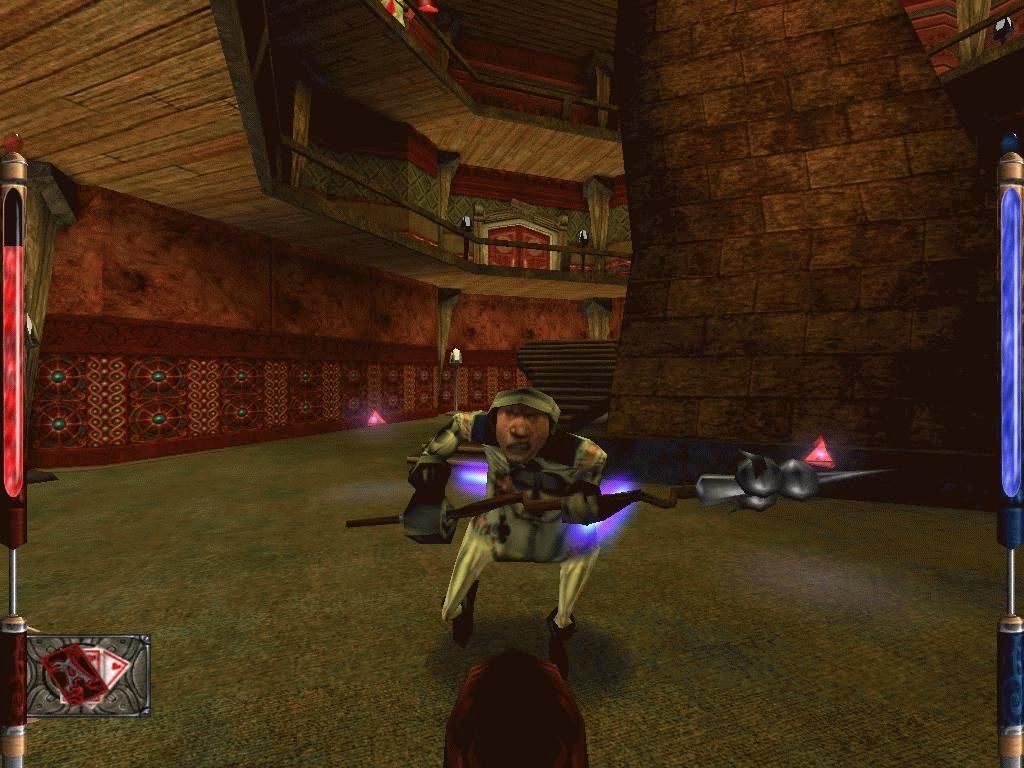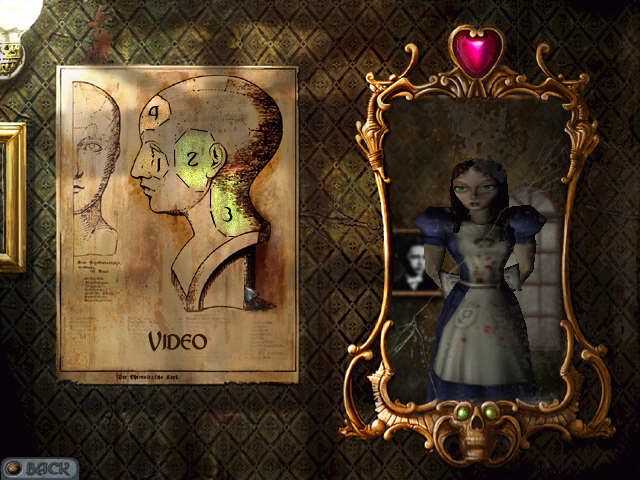Retro Replay Review
Gameplay
American McGee’s Alice delivers a tightly focused third-person action experience that blends melee combat, ranged attacks, platforming, and light environmental puzzle-solving. From the moment Alice retrieves her faithful knife, players learn to balance precision strikes with more strategic, thrown-knife attacks. As you progress, the game gifts you an eclectic arsenal—magic-staff energy bolts, poison-emitting dice, a time-stopping pocket watch, and more—each with a powerful alternate fire that drains your mystical energy pool in exchange for devastating effect.
(HEY YOU!! We hope you enjoy! We try not to run ads. So basically, this is a very expensive hobby running this site. Please consider joining us for updates, forums, and more. Network w/ us to make some cash or friends while retro gaming, and you can win some free retro games for posting. Okay, carry on 👍)
Combat encounters are frequent and challenging. Enemies range from twisted playing cards to malformed flora, and each foe demands different tactics. Melee weapons excel at crowd control, while ranged tools are indispensable against flying or heavily armored adversaries. To survive, you must harvest “essence” from fallen enemies to refill health and magic. This risk-reward loop encourages aggressive play and careful resource management, especially in boss fights that push your mastery of each weapon’s primary and alternate attacks.
Beyond brawling, Alice must traverse a series of warped environments filled with hazards and platforming puzzles. Leaping across broken tea tables, shimmying up crushed pillars, and timing jumps over gouts of flame test your reflexes as much as your combat skills. Puzzle segments typically involve manipulating switches, rolling giant cards into place, or using the environment to open new passages. These interludes break up the action with moments of quiet exploration and reward observation over button-mashing.
Graphics
Released in the early 2000s, American McGee’s Alice remains visually striking despite its age. The game’s art direction—overseen by McGee himself—turns Lewis Carroll’s whimsical wonderland into a gothic nightmare. Every level feels like a twisted storybook page: jagged architecture, dripping chandeliers, and blood-red roses that shrink from Alice’s approach. This stylized presentation masks the game’s relatively simple geometry and lower-resolution textures, creating an atmosphere that feels fresh even today.
Character and creature designs are a highlight. Card soldiers sport chipped helmets and rusted lances; Cheshire Cats prowl with razor-sharp grins; and the Caterpillar exhales poisonous puffs as he taunts you. These nightmarish interpretations lean heavily into the macabre, giving each encounter a visceral punch. Lighting and color palettes shift dramatically from level to level, ensuring that no two areas feel visually redundant while maintaining a cohesive, unsettling aesthetic.
On modern systems, the game has received compatibility updates and higher-resolution textures when packaged with Alice: Madness Returns, making its world crisper and more detailed than in its original form. Widescreen support and improved controller mappings further enhance playability. While it can’t compete with today’s graphical powerhouses, the surreal art style and bold design choices ensure American McGee’s Alice ages more gracefully than many of its contemporaries.
Story
American McGee’s Alice picks up on a tragic note: a house fire claims her parents, and Alice emerges as the sole survivor. The trauma sends her spiraling into despair, and repeated suicide attempts land her in an asylum, where she teeters on the brink of oblivion. This psychological abyss sets the stage for the White Rabbit’s summons—and Wonderland’s twisted rebirth as a reflection of Alice’s shattered mind.
Unlike Carroll’s lighthearted nonsense, this story probes themes of loss, mental illness, and the desperate search for closure. Wonderland’s horrors are more than mere enemies; they’re symbolic manifestations of Alice’s guilt and grief. As you battle grotesque Cheshire Cats or scale the ominous, mushroom-choked corridors, you’re not just fighting for your life—you’re fighting for sanity itself and seeking answers about the fire that destroyed her home.
The narrative unfolds gradually through brief cutscenes, in-world dialogue, and environmental storytelling. A voice-over by Alice herself provides internal monologue, granting insight into her fragile psyche. Though the script is lean, every line underscores the stakes: restore Wonderland or remain lost in darkness. This direct sequel to Through the Looking-Glass builds on Carroll’s foundations but tells a wholly original, mature tale that resonates with anyone who’s faced tragedy and sought escape through fantasy.
Overall Experience
American McGee’s Alice stands as a landmark in dark fantasy gaming, merging visceral action with a richly imagined, psychological world. Its strengths lie in the seamless interplay of combat, platforming, and puzzling—each element supporting the haunting narrative rather than feeling tacked on. The game’s pacing rarely lets you rest, yet it also offers quiet moments of exploration that deepen the sense of wonder amid the terror.
Atmosphere is the game’s crowning achievement. From the skittering background music laced with distorted nursery rhymes to the ambient sounds of dripping water and distant screams, every audio-visual cue reinforces the idea that this Wonderland is Alice’s own personal hell. The marriage of sound design and art direction creates an immersive, unsettling world you’ll want to explore, even when your heart races at every corner.
While some modern players may find the controls and camera a bit dated, American McGee’s Alice remains a must-play for fans of narrative-driven action. Its unique vision, emotional depth, and inventive level design ensure that, more than two decades later, it still cuts a striking figure in gaming history. For mature audiences seeking a dark twist on a classic tale, this twisted odyssey through the looking glass delivers an unforgettable journey.
 Retro Replay Retro Replay gaming reviews, news, emulation, geek stuff and more!
Retro Replay Retro Replay gaming reviews, news, emulation, geek stuff and more!









Reviews
There are no reviews yet.